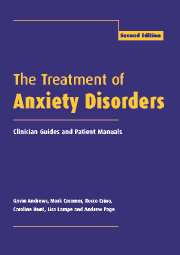Book contents
- Frontmatter
- Contents
- List of authors
- Preface to the second edition
- Abbreviations
- 1 Read me
- 2 General issues in anxiety disorders
- 3 General issues in treatment: Clinician Guide
- 4 Panic disorder and agoraphobia: Syndrome
- 5 Panic disorder and agoraphobia: Treatment
- 6 Panic disorder and agoraphobia: Clinician Guide
- 7 Panic disorder and agoraphobia: Patient Treatment Manual
- 8 Social phobia: Syndrome
- 9 Social phobia: Treatment
- 10 Social phobia: Clinician Guide
- 11 Social phobia: Patient Treatment Manual
- 12 Specific phobias: Syndrome
- 13 Specific phobias: Treatment
- 14 Specific phobias: Clinician Guide
- 15 Specific phobias: Patient Treatment Manual
- 16 Obsessive-compulsive disorder: Syndrome
- 17 Obsessive-compulsive disorder: Treatment
- 18 Obsessive-compulsive disorder: Clinician Guide
- 19 Obsessive-compulsive disorder: Patient Treatment Manual
- 20 Generalized anxiety disorder: Syndrome
- 21 Generalized anxiety disorder: Treatment
- 22 Generalized anxiety disorder: Clinician Guide
- 23 Generalized anxiety disorder: Patient Treatment Manual
- 24 Posttraumatic stress disorder: Syndrome
- 25 Posttraumatic stress disorder: Treatment
- 26 Posttraumatic stress disorder: Clinician Guide
- 27 Posttraumatic stress disorder: Patient Treatment Manual
- 28 Conclusions
- References
- Index
25 - Posttraumatic stress disorder: Treatment
Published online by Cambridge University Press: 05 August 2016
- Frontmatter
- Contents
- List of authors
- Preface to the second edition
- Abbreviations
- 1 Read me
- 2 General issues in anxiety disorders
- 3 General issues in treatment: Clinician Guide
- 4 Panic disorder and agoraphobia: Syndrome
- 5 Panic disorder and agoraphobia: Treatment
- 6 Panic disorder and agoraphobia: Clinician Guide
- 7 Panic disorder and agoraphobia: Patient Treatment Manual
- 8 Social phobia: Syndrome
- 9 Social phobia: Treatment
- 10 Social phobia: Clinician Guide
- 11 Social phobia: Patient Treatment Manual
- 12 Specific phobias: Syndrome
- 13 Specific phobias: Treatment
- 14 Specific phobias: Clinician Guide
- 15 Specific phobias: Patient Treatment Manual
- 16 Obsessive-compulsive disorder: Syndrome
- 17 Obsessive-compulsive disorder: Treatment
- 18 Obsessive-compulsive disorder: Clinician Guide
- 19 Obsessive-compulsive disorder: Patient Treatment Manual
- 20 Generalized anxiety disorder: Syndrome
- 21 Generalized anxiety disorder: Treatment
- 22 Generalized anxiety disorder: Clinician Guide
- 23 Generalized anxiety disorder: Patient Treatment Manual
- 24 Posttraumatic stress disorder: Syndrome
- 25 Posttraumatic stress disorder: Treatment
- 26 Posttraumatic stress disorder: Clinician Guide
- 27 Posttraumatic stress disorder: Patient Treatment Manual
- 28 Conclusions
- References
- Index
Summary
Survivors of trauma who do not recover independently, and who go on to develop longer-term problems as a result of their experiences, may require formal treatment. There is also a mounting body of research suggesting that early interventions with high risk survivors may facilitate the recovery process and reduce the prevalence of subsequent PTSD. The purpose of this chapter is to provide a brief overview of common interventions used in the treatment of acute stress disorder (ASD) and PTSD, and to discuss their application as a preventive strategy.
Aims of treatment
It is reasonable to assume that virtually all human beings will experience a psychological reaction to very frightening or upsetting events. This raises questions about what constitutes an adaptive psychological response to trauma and, as a corollary, what are reasonable treatment goals. Severe traumatic events profoundly affect survivors’ views of themselves and the world. In most cases, it is reasonable to suggest that the survivor will never be the same person again. Equally, those changes need not all be bad. Recovery from trauma can result in personal growth, with the development of improved coping strategies and more adaptive models of the self and the world.
Ideally, treatment would serve to eliminate all the symptoms of PTSD and return the survivor to pretrauma levels of functioning. In reality, that will not always be possible. As with other disorders, factors such as the severity of the condition, chronicity, and comorbidity (particularly in the form of axis II disorders) are likely to affect treatment efficacy. In acute cases of PTSD with few complications, it is reasonable to expect a high degree of success with relatively few sessions (6 to 10). In such cases, elimination of PTSD symptoms, a return to prior functioning, and low risk of relapse would be achievable goals. (Importantly, this is not to imply that the person will never again experience distressing memories of the event but, rather, that such intrusive phenomena will be infrequent and manageable). On the other hand, treatment goals for affietnam veteran with, forexample, a 30-year history of PTSD, high levels of comorbid alcohol abuse, and poor social and occupational functioning, would be more conservative. It may be a question of helping that person to manage the symptoms more effectively, reducing their impact on quality of life, relationships, and general functioning.
- Type
- Chapter
- Information
- The Treatment of Anxiety DisordersClinician Guides and Patient Manuals, pp. 480 - 491Publisher: Cambridge University PressPrint publication year: 2002



